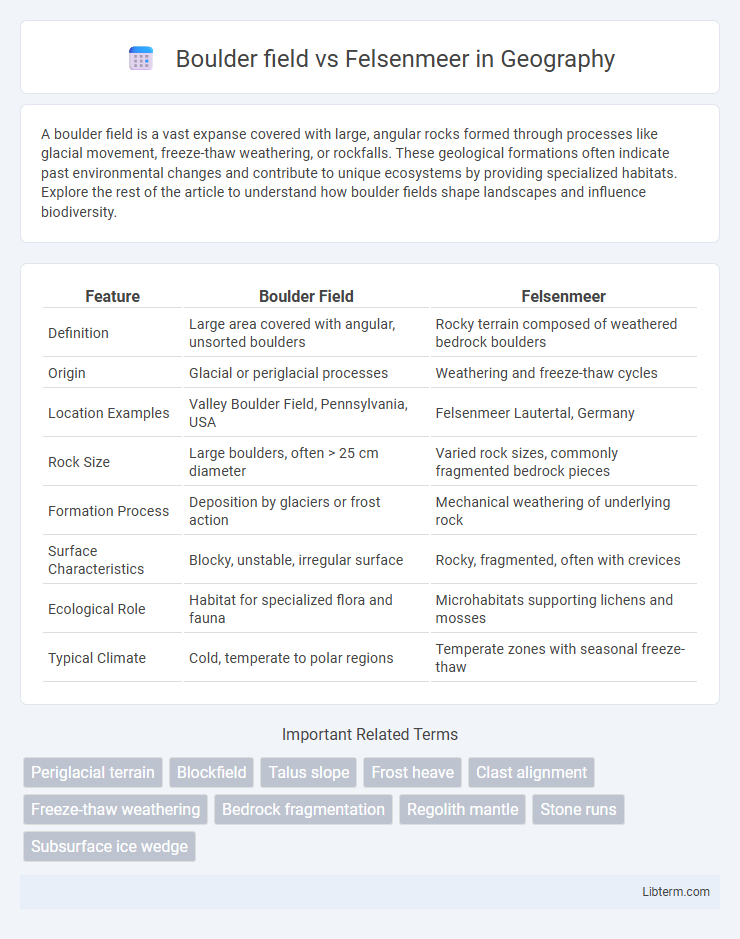A boulder field is a vast expanse covered with large, angular rocks formed through processes like glacial movement, freeze-thaw weathering, or rockfalls. These geological formations often indicate past environmental changes and contribute to unique ecosystems by providing specialized habitats. Explore the rest of the article to understand how boulder fields shape landscapes and influence biodiversity.
Table of Comparison
| Feature | Boulder Field | Felsenmeer |
|---|---|---|
| Definition | Large area covered with angular, unsorted boulders | Rocky terrain composed of weathered bedrock boulders |
| Origin | Glacial or periglacial processes | Weathering and freeze-thaw cycles |
| Location Examples | Valley Boulder Field, Pennsylvania, USA | Felsenmeer Lautertal, Germany |
| Rock Size | Large boulders, often > 25 cm diameter | Varied rock sizes, commonly fragmented bedrock pieces |
| Formation Process | Deposition by glaciers or frost action | Mechanical weathering of underlying rock |
| Surface Characteristics | Blocky, unstable, irregular surface | Rocky, fragmented, often with crevices |
| Ecological Role | Habitat for specialized flora and fauna | Microhabitats supporting lichens and mosses |
| Typical Climate | Cold, temperate to polar regions | Temperate zones with seasonal freeze-thaw |
Introduction to Boulder Fields and Felsenmeer
Boulder fields, vast expanses of large rock fragments, form primarily through frost weathering and mechanical breakdown of bedrock in cold climates. Felsenmeer, a German term meaning "sea of rock," refers to similarly extensive, blocky debris fields created by freeze-thaw cycles, typically found in periglacial environments. Both geological phenomena showcase natural processes of rock disintegration and accumulation, providing insights into past climatic conditions and erosion patterns.
Defining Boulder Fields: Characteristics and Formation
Boulder fields, characterized by vast expanses of angular rock fragments, form primarily through frost weathering that fractures bedrock over millennia in periglacial environments. These fields, often found at high altitudes or latitudes, display poorly sorted, angular boulders lacking significant soil development underneath. In contrast, Felsenmeer specifically refers to rock seas with densely packed, interlocking blocks, resulting from similar freeze-thaw processes but distinguished by a more coherent rock surface pattern.
Understanding Felsenmeer: Features and Origins
Felsenmeer, a German term meaning "sea of rocks," refers to extensive fields of large angular boulders formed primarily through frost weathering in periglacial environments. These rock fields are characterized by closely packed, jagged stones created by freeze-thaw cycles that fracture bedrock over millennia. Unlike typical Boulder fields, which may include rounded or transported rocks, Felsenmeer distinctly represents in-situ weathering with minimal erosion displacement, offering insights into past climatic conditions and geological processes.
Geological Processes Behind Boulder Fields
Boulder fields and Felsenmeer both form through physical weathering processes, primarily freeze-thaw cycles that fracture bedrock into angular rocks. Boulder fields commonly arise in periglacial environments where repeated frost wedging causes rock disintegration and the accumulation of large boulders. Felsenmeer, a German term meaning "sea of rock," typically refers to surface rock debris resulting from spheroidal weathering, mass wasting, and localized erosion in temperate to cold climates.
Climatic Influence on Felsenmeer Development
Felsenmeer formations primarily develop in periglacial climates where freeze-thaw cycles dominate, causing intense mechanical weathering and rock fragmentation. This contrasts with typical Boulder fields that form in a range of climates but lack the pronounced freeze-thaw influence necessary for Felsenmeer creation. The climatic conditions driving Felsenmeer development enhance angular rock breakdown, leading to the characteristic sea of jagged boulders.
Key Differences: Boulder Field vs Felsenmeer
Boulder fields and Felsenmeer both consist of rocky landscapes shaped by freeze-thaw weathering, but key differences lie in their formation and appearance. Boulder fields generally feature large, angular rocks scattered across a slope, often formed by physical weathering in cold mountain environments, whereas Felsenmeer refers to a stone sea comprised of densely packed, angular blocks typically formed in periglacial regions. Soil presence is usually minimal in both, but Felsenmeer areas tend to have a more uniform cover of fragmented bedrock compared to the irregular, isolated boulders in a boulder field.
Global Examples of Notable Boulder Fields
Boulder fields, also known as Felsenmeer in German, are extensive accumulations of large rock fragments found in periglacial environments worldwide. Notable global examples include the Devils Postpile in California, the Hohes Venn in Belgium, and the Afon Llugwy boulder field in Wales, each exhibiting unique geological formations shaped by frost weathering and freeze-thaw cycles. These natural rock formations provide valuable insights into past climatic conditions and ongoing tectonic processes.
Famous Felsenmeer Locations Worldwide
Felsenmeer, a German term meaning "sea of rocks," describes extensive fields of angular boulders formed primarily by freeze-thaw weathering, prominently found in the Odenwald region of Germany. Unlike typical boulder fields, which may result from glacial deposits, famous Felsenmeer locations include the Felsenmeer Lautertal in Hesse and the Granitformation near Kirchheimbolanden, known for their striking geomorphological features and cultural significance. These sites attract geologists and tourists due to their unique rock formations and well-preserved natural landscapes showcasing Periglacial processes.
Ecological Significance and Environmental Impact
Boulder fields and Felsenmeer both support unique ecological niches, providing habitats for specialized flora and fauna adapted to rocky, nutrient-poor environments. Boulder fields often play a critical role in soil stabilization and water retention in mountainous regions, while Felsenmeer, with its dense aggregation of rock fragments, contributes to microhabitat diversity and influences local microclimates. Both formations impact their ecosystems by affecting species distribution and ecological succession, highlighting their importance in maintaining biodiversity and ecosystem resilience.
Preservation and Study: The Importance for Geology
Boulder fields and Felsenmeers serve as crucial natural laboratories for geologists studying periglacial processes and weathering patterns. Preservation of these formations allows for detailed analysis of rock fragmentation, climatic influences, and landscape evolution over time. Protecting these sites ensures ongoing opportunities to understand Earth's geological history and aids in reconstructing past environmental conditions.
Boulder field Infographic

 libterm.com
libterm.com